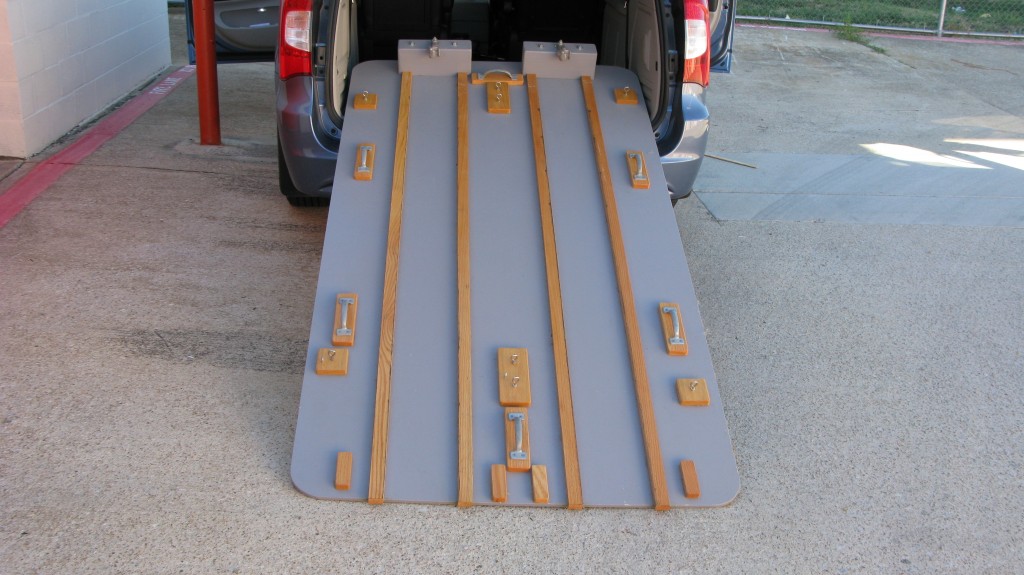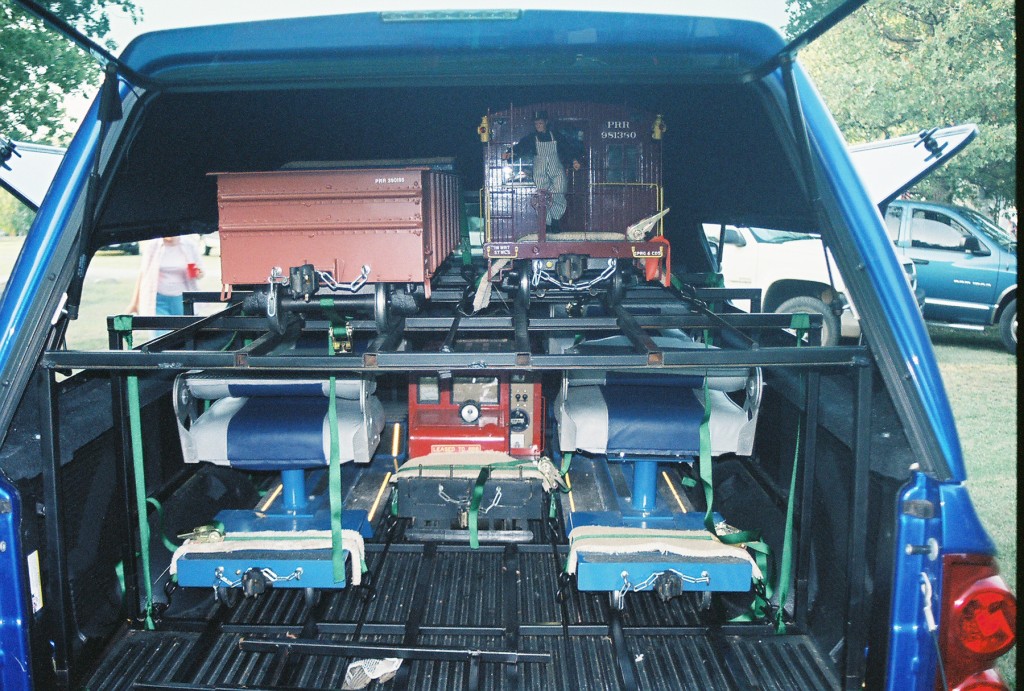Transportation of 1.5” Scale Equipment – More Options
When I was able to lease a box cab from Jack Haskins, I wanted to haul it to meets. Since I own a minivan, I decided to build a deck that would fit in the rear of the van.
I built the deck from ¾” plywood with 1 X 2” oak rails. The rails were spaced 2 5/8” apart and screwed to the plywood from the bottom with flat head screw. Tie down points were chosen, and ¼” eyes were bolted to the plywood. To secure the eyes, I routed out a space on the under side to accommodate fender washers and nuts. This provided adequate strength and a smooth bottom surface to slide into the van. Dummy couplers were lag-bolted to front blocks that rested against the front seat frames. I also added handles which allows easy handling for one person. They also provide additional hold down points. All in all, this is an adequate solution for anyone with a van/SUV and a small locomotive.
For an operation meet, a caboose can be mounted on top of the riding car. I removed the seats and pedestals (wing nuts) from my riding car and located temporary oak rails in their place. The caboose can be tied down to the riding car prior to loading. The Van Platform is a versatile method of transport. The deck can be removed and stored in a motel room. It does not take much space in a garage. It is great for transporting/picking up cars from a location or transporting a locomotive.
| Advantages | Disadvantages |
| Simple and quick to build | Limited to two tracks |
| Economical solution | Limited in weight |
| Great ride for the equipment | Reduces van seating |
| Versatile in use | |
| Easily removed |
My next effort in transporting 1.5” equipment was a pickup truck. I found the decision on what to purchase difficult due to the many options. Pickups are commonly used for transporting our trains, and it was easy to ask the opinion of many well known large scale hobbyists. The decision boiled down to the following questions:
- Is the truck also going to be used as a normal transportation vehicle?
- Will I need to pull a small trailer, large trailer or mobile home?
- What do I want to carry in the truck?
- Do I care if it is diesel or gas?
- Do I want to cover equipment with canvas or a camper shell?
In my case, the vehicle’s main job was to haul trains and protect them from weather, etc. I might want to tow a small trailer, and I wanted to load five items to make an “operation” train. I also wanted room for luggage, tools, etc. I found a crew cab 1 / 2 ton truck with an 8’ bed and added a tall camper shell. It should be noted that given a choice of side windows on the shell, the long single version windows gives the best access.
To build the rack, I chose 1” square tubing (heavy gauge on top and light gauge on bottom). I drew a scale drawing of the bottom level by dividing space evenly between the wheel wells for the three tracks. Connecting the track rails was accomplished with ¾” square tubing. I did the same thing for the top level, making sure that there was adequate room between the shell sides. I planned long legs to be welded to the top and short legs to the bottom. This allowed for sections of ¾” within each leg and adjusting 1” collars, as needed, to match the car heights. This also allowed the top section to be removable. Using a cut list, the parts were cut and welded together.
A bar welded at the correct height provided a place for dummy couplers on each level. A real coupler is recommended for the bottom center due to reduced access from the camper shell. Also, by placing the upper level couplers back, room is available for a storage shelf behind the cab.
By leaving the ends of the 1” tubing open, the flexibility of using ¾” tubing “extenders” is sometimes an asset for loading and unloading. A “stop” can be designed to fit between the rear locomotive coupler and a corresponding track cross brace. This locks in the locomotive.
This method of transportation worked very well, and the rack described above is now in another pickup of a different manufacturer.
| ADVANTAGES | DISADVANTAGES |
| Easy load/unload | Limited trailer towing capacity (1/2 ton) |
| 1/2 ton truck is a good ride | Rear camper shell reduces flexible use |
| 1/2 ton truck is easy on equipment | Maximum of 5 rolling stock |
| Adaptable to towing small trailer | Poor gas mileage |
| Very adequate for “operation” train | Upper level is difficult to unload at some tracks |
| Crew cab space for flexible use | Sticker price goes up fast with large HD trucks |
| HD trucks provide rougher ride for the equipment |



